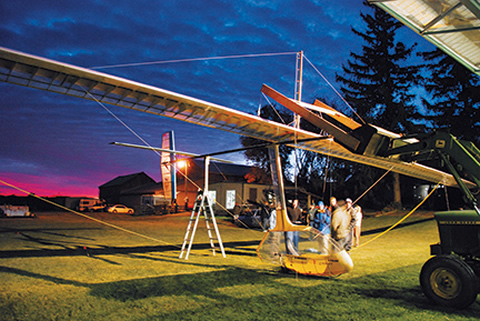There may be no one who better understands how Douglas McCurdy felt during his first flight a century ago than Todd Reichert, who is an engineering PhD student at U of T.
Last August, in Tottenham, Ontario, Reichert became the first person to fulfil the vision Leonardo DaVinci set down in his notebooks in 1485 – of flying a human-powered vehicle through the air like a bird. “This is the original aeronautical dream,” Reichert says. “Humans have always wanted to fly like birds.”
On a quiet summer morning, Reichert pedalled hard to get his 43-kilogram craft’s immense wings flapping; at 32 metres from tip to tip, the Snowbird’s wingspan equals that of a Boeing 737. Aloft for 20 seconds, the “ornithopter” covered a distance of 145 metres at an average speed of 26 kilometres an hour.
Like McCurdy before him, Reichert had a core group of four behind him: U of T professor emeritus James DeLaurier, playing the role of Alexander Bell; Cameron Robertson (MASc 2009), the chief structural engineer; and two aviation enthusiasts from Vancouver, high school student Robert Dueck and his father, Carson. They call themselves the “five amigos.”
Another 30 U of T students helped during the four years of designing and building the craft. The key engineering problem: the wings had to shift their angle of attack between the upstroke and downstroke, thereby providing sufficient lift and forward propulsion.
Like his predecessor McCurdy, Reichert had his share of bad landings along the way: “I never flew higher than I was willing to fall. I did get a scratch once, but mainly when I was coming in for a crash, I was thinking, ‘Oh crap, we have to repair this thing.’”







No Responses to “ Like a Bird ”
I love when distinguished scientists prove themselves wrong. Congratulations! How high was it off the ground and why is it called what it is? Is there a steering mechanism to it as well?
Amazing stuff! Question: why? I guess i know the answer, but what a lot of time and money just to prove a point. There's no economical reason, just an ego trip. Is there a purpose to this project?
CONGRATULATIONS! Heart- stopping!
Congratulations!
"Why?" you ask.
"Why NOT!"
Congratulations!